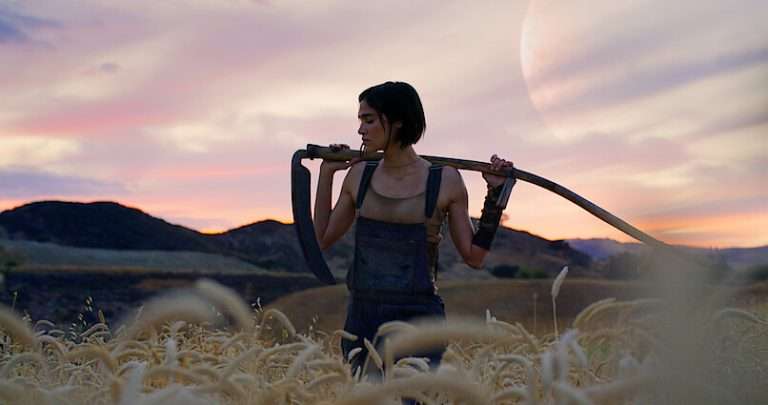John Skoog’s “Redoubt” (2025) features Denis Lavant as a kind and idealistic man trying to do good during some uncertain times. He feels like a beacon of hope for the townsfolk, who are living through the times of a cold war. There’s a naive simplicity to his optimism that makes him seem like a warm presence to be around. There are shades of Forest Gump (the character, not the film) and Fred Rogers to his character in the film’s 20th-century setting. That seems unlike the kind of roles Lavant is more popular for, where the intensity in his performance and his physical expression have usually been the highlights.
Take any of his collaborations with Leos Carax, “Holy Motors,” “Lovers on the Bridge,” or “Bad Blood.” You can sense the same intensity in his full-bodied performance. Whether the accordion scene from a hallway or an acrobatic dance performance to Modern Love or Rhythm of a Night, he uses his physicality to express something raw and visceral, while staying true to the film’s emotional core. In comparison, his performance in “Redoubt” is more naturalistic, where he relies more on fleshing out the character’s interiority rather than their physicality or his idiosyncrasies. The result, in this case, is an endearing portrait of a man who celebrates life despite the looming threats of death.
Of course, it’s not the first time we have seen Lavant’s performance dealing more with the internal than the external. Claire Denis’s “Beau Travail” shows his performance cutting through the character’s deep-seated anguish about the lack of agency and control. He appears rather cold and distant around young, obedient soldiers in his crew. So, it feels like a ruse he puts on so that he can maintain his higher status in these masochistic spaces, far away from the comforts of their home. The same act ends up revealing his underlying fears that he is desperately trying to mask. Lavant’s latest performance is similarly layered.
Also Read: Holy Motors [2012]: The Death & Rebirth of Cinema
In “Redoubt,” the French actor plays an endearing simpleton in a way that makes you sense his joys and sorrows, often in equal breath. His performance leaves you with a bittersweet aftertaste, which may remind you of Charlie Chaplin’s work, where your heart goes out to his character, even when he is taunted or ridiculed. These characters are heroes to some, while buffoons to others. Still, Chaplin makes you care deeply for nearly every one of them.
Lavant channels something similar through his work in Skoog’s film. He plays Karl-Göran Persson, a farm worker from 20th-century Sweden, deeply concerned about potential attacks while living through the uncertain times of the Cold War. At the time, the citizens had begun receiving safety instructions in case they couldn’t escape a similar tragedy. It frightened Persson to the point that he decided to build a fortress, as a stronghold, against the impending threats to his survival. He started collecting anything and everything he could find to assemble it piece by piece. So, it looked like someone clumsily put together bits of metal, scraps, or wood.

Regardless of its appearance, Persson built this structure in a way to suit its defensive purpose. Skoog’s film addresses both the literal and metaphorical aspects of this haphazardly built fortress. He and cinematographer Ita Zbroniec-Zajt focus on the textural details around this structure through their gorgeous black-and-white frames. They find beauty in the mundane patterns of any material that the character uses, in ways he might have found the beauty in those things. So, even the glistening soft patterns of tar or the rough textures of his patchy walls feel tangible on screen.
Must Explore: The 20 Best French Movies of the Decade (2010s)
Besides the visual, there’s another layer to Persson’s story, as he builds these walls around himself as a middle-aged, unmarried man. Despite his inward nature, he seems harmless and jovial. We see him bringing out his inner child while playing with the kids. Otherwise, he is detached from the world and is profoundly alone. Writer-director Skoog bases Lavant’s character on a real-life Persson, who built a similar fortress in his town. Skoog presumably changed some details to highlight the present-day anxieties of an impending doom.
In his film, we see Persson as an introverted but selfless, sentimental but determined individual, whose fears guide him to make most of his decisions. He closes in on himself after being turned into a laughingstock, but does everything in his power to ensure safety for everyone around him. Persson’s film gets better when it deals with this character portrait and trusts its lyrical instincts. However, it doesn’t reveal enough about the reasons behind Persson’s burgeoning anxieties. It shows people dancing to a song that sounds like the last hurrah before the tragedy strikes, while Persson sits aside quietly, stooped, and lost in thought. He doesn’t retaliate but recoils when something or someone bothers him.
While it all highlights his isolation and a universal fear of a looming tragedy, the script lacks the specificity to cut deeper. Skoog gets the gloomy mood right with Lavant’s aid, but his script feels underwritten for a project that would have benefited from a deeper insight into the cultural and historical context of that era.




![This Is Not a Burial, It’s a Resurrection [2020]: ‘Sundance’ Review – A haunting parable about loss of individual and collective identity](https://79468c92.delivery.rocketcdn.me/wp-content/uploads/2020/01/This-Is-Not-a-Burial-Its-a-Resurrection3-highonfilms-768x432.jpg)



